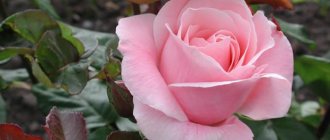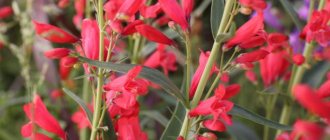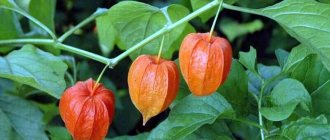The thin-leaved peony is a real miracle of nature. Imagine a green, juicy, very shaggy carpet and on it large red flowers, similar to very open poppies. And all this in May, when you really want new colors!
The thin-leaved peony is native to southeastern Europe and the Caucasus. This rare beauty is listed in the Red Book in both Ukraine and Russia. The steppe “savage” attracted the attention of gardeners and now many different varieties have been bred for the garden. Let's take a closer look at this miracle.
Thin-leaved peony flower
This peony is also called narrow-leaved because it has thin leaves, like the needles on a Christmas tree. It is thanks to them that the effect of shaggy bushes is created. And when the peony grows, the plantation becomes like a carpet strewn with red beauties (Figure 1).
Figure 1. During flowering, the crop forms a lush carpet
But even after the peony has faded, the greenery of this plant continues to please the eye. This is probably why another name for it is greenberry. This crop, due to its decorative nature and unpretentiousness to growing conditions, is often used for landscaping and landscape design.
Medicinal properties
Peony angustifolia, which is usually grown for decorative purposes, is also used to treat a number of diseases. Its diuretic, antispasmodic and sedative effects have been known in folk medicine for a long time. Peony rhizome is used to prepare various home remedies that are used to treat gout, anemia, and nervous diseases. A decoction of the root also helps with heart pain, stones in the bladder and kidneys, and concussions.
It should be remembered that when using products based on this plant, it is very important to follow the dosage, since peony roots contain a high content of a toxic substance called neonin. Therefore, before use, it is better to consult your doctor.
Botanical description
This peony belongs to the ranunculaceae family. The stems are straight, on average reaching half a meter, thread-like trifoliate-pinnate leaves. The roots are straight with knots. Flowers come in different shades of red, 8-10 petals per bud, golden center with a large number of anthers (Figure 2).
Figure 2. Externally, the culture looks very unusual and is highly valued by landscape designers
The petals are smooth, but in the bred varieties they are also velvety. Peony blooms in May, briefly and simultaneously, for 10-12 days. After flowering, the bush remains green until the end of summer, then gradually dries up to the rhizome. Peony thin-leaved is a perennial and can grow in one area for decades.
Mid-early varieties of peonies with photos and names
Below are varieties of peonies with photos and descriptions that bloom from June 10 to June 15.
"Duchess De Nemours". One of the first garden varieties. The bush is up to 1 m high. The buds are white, in the center with a greenish-yellow tint, with a diameter of 19 cm. The flower has the smell of lilies of the valley, straight long stems. The leaves are large, dissected. Grows well in any soil. Very frost-resistant. Looks great in a flower bed, in group plantings, and looks very nice in a single planting.
"Mirage". The bush is tall, reaches 110 cm, very beautiful. The buds are of the Japanese type, light crimson in color, the stamens are modified, the same color with gold. The petals are large, ellipsoidal in shape. The flower is 13cm in diameter and has a strong jasmine scent. The stems are strong, highly branched, the leaves are dark green. An excellent park variety.
"Miss America" The height of the bush is up to 80 cm. When blooming, the buds are pink, then they become white with 6 rows of petals and bright yellow stamens. The diameter is 25 cm, the stem is strong. The variety is winter-hardy and does not require additional shelter. Grows well in open space with plenty of light. Do not plant in an area where groundwater rises high, otherwise the roots will rot. It is recommended to plant at a distance from buildings and shrubs to reduce shading.
Bridle Shower. Herbaceous variety. The height of the bush can reach from 85 to 100 cm. The buds are terry, white, in the center there are cream-colored petals, gathered into a dense ball. There are 2 rows of outer petals. The first flowers may have a pink blush. Diameter - 20 cm. The leaves are quite large, shiny, bright green. The stems are strong, strong, reddish in color, on which there are 4 buds. The flower has a pleasant but weak aroma.
Planting and care
Thin-leaved peony is an unpretentious plant that can feel great in one place for up to 15 years.
Note: In general, nothing special is needed for this handsome guy, and yet you can easily create special “sanatorium” conditions for him. Peony will thank you with its unique beauty.
You can choose a site that is sunny or with occasional shade, but not in the shade. Peony loves neutral or alkaline soil, possibly fertile, but some also thrive in poor or rocky soil. The native soil of the “savage” is limestone. If the soil is acidic, add lime and ash. This will help her become neutral (Figure 4).
Figure 4. The plant is best planted in well-lit areas
Also, when choosing a place for this species, it is important to take into account that there are no drafts in the area. Plant them somewhere near the fence and this delicate creature will thank you with abundant and long-lasting flowering.
Periodically you need to loosen the soil, about 5-7 cm deep and do not forget about the mulch. This way you will kill two birds with one stone - you need to water less often, and there will be no weeds.
It is better to remove the buds in the first couple of years so that the plant takes root well and the nutrition is thus directed in the right direction. Of course, this is a sacrifice, but in the end we will get a strong, healthy plant. In the future, during flowering, remove small flowers, then the buds will not be crushed.
Watering schedule and fertilization
Peony does not like strong humidity, except perhaps just before flowering. If there is stagnation of moisture in the area, the rhizomes will rot, and you will say goodbye to the peony. In dry weather, the peony can be watered 3 times a week (Figure 5).
Figure 5. Peony needs abundant watering, but without stagnation of moisture.
It is better to fertilize before flowering and during the flowering period, then the peony will please you longer with its red accents. Nitrate or urea is suitable for spring feeding, and potassium and phosphorus can be used for autumn feeding. The thin-leaved peony is frost-resistant, so it does not require wrapping or digging for the winter.
Reproduction options
There are several options for how to propagate a peony. This is by seeds, cuttings and vegetatively (by division). The last method is the simplest and most useful (Figure 6).
Note: Although, as we wrote above, a peony can live in one place for up to 15 years, but without separating old plants from young ones, the flower gradually becomes smaller and the flowering itself becomes less long and abundant. Therefore, by dividing we will kill two birds with one stone. And let's multiply our peony and free it from old rhizomes.
So, if we have an adult plant that is already five years old, then in the fall we dig it up, separate the old rhizomes and throw them away, and from the mature plant we separate a couple of roots with buds (at least 2, and preferably 3-4). The cut area should be sprinkled with wood ash to disfigure it. We plant in the hole, having previously fertilized the soil, so that the buds cover about 5 cm of soil. We make a small hill on top and mulch. There is no need to compact the soil to avoid damaging the fragile roots. Leave about 1-1.5 meters of free space between plants. You can plant the peony in its original place, or you can take the opportunity and transplant it to a new one. You decide.
Figure 6. Peony can be propagated both by seeds and vegetatively
Another method of propagation is by seeds. It is more labor-intensive and unpleasant because the seeds may not sprout. And one more thing - if you grow a peony this way, you will see the first flowering in about five years. But, if you still decide, then collect the seed boxes in July, when they have not yet opened. Place them in the refrigerator, wrapped in paper, and take them out in October. Then place the seeds removed from the boxes on paper and hide them in a dark place where the temperature will not exceed 15°C. After a month, plant them in a permanent place in the garden.
And let's talk about the third method of propagation - cuttings. In mid-autumn, when the root is already fully formed, we separate vertical layers from the roots. We prepare deep holes, about 70x80 cm. We plant them in the same way as when dividing the bush, but the distance between the plants is smaller - 70 cm, and we insulate the cuttings themselves with mulch and spruce branches. In the spring we remove the insulation. Since peony is unpretentious and easily takes root, this method also works well.
Peculiarities
Tree peonies are deciduous shrubs that often grow up to 1.5-2 meters. The plants are characterized by erect, pale brown stems that grow thicker and sturdier every year.
The feathery leaves have an openwork shape and look very unusual. The flowers are located at the ends of the shoots and reach a diameter of 12-20 cm. They come in double, semi-double and simple types and have a very wide color palette. The color of the flowers can be very different, ranging from bright white to soft green, blue and purple hues.
Moreover, among the huge variety of varieties there are also very interesting two-color specimens. The petals of such flowers have a gradient, when one shade smoothly transitions into another. A characteristic feature of tree peonies is the increase in the number of flowers over time. As a result, an adult bush is a bright flowering ball, which often becomes the main decoration of a summer cottage.
At the same time, 70 flowers can be present on one bush, despite the fact that the flowering phase of each of them lasts from 8 to 10 days. Due to the large volume of the bush, it is recommended to plant peony separately from other garden species or at some distance from them.
Typical pests and diseases
Insects do not like this plant, so the peony is in almost no danger. Unless the omnivorous aphid disdains peony, and then out of despair. It's very easy to fight her. A soap solution with tobacco or garlic infusion will help you. During the flowering period, a turf ant may visit; it loves the flower itself. If you know that you have such “comrades”, then treat the bushes and the ground around them with special means in advance so as not to spoil the already short flowering.
Of the diseases, only fungal ones are dangerous; they can occur due to very rainy weather or an incorrect watering schedule. Copper-containing solutions will help.
Peony thin-leaved is a picky resident. And, if you want to place it in your garden, it will delight you and your guests for many years, expecting practically nothing in return.
Description and popular varieties
The peony growing in natural conditions is called Voronets. Nowadays, there are more than 20 representatives of herbaceous and shrub peonies. Wild representatives: evasive peony (Maryin root) and Wittmann peony. Steppe peony grows in the Voronezh region. Its graceful stem is covered with thin leaves, and in the center there is a bright flower.
Through the work of breeders, the terry peony was bred. It does not produce seeds and reproduces only by dividing the root. Reproduction is carried out in August, when the plant enters a dormant period. Rhizome fragments take root with difficulty, so planting material is expensive.
Hybrid varieties:
- The eaglet with red flowers and dissected leaves reaches a height of 60 cm.
- Airlie Scout with cherry-colored flowers and small dark green leaves.
- Tiny Tim has a regular bush shape and fast-blooming semi-double flowers.
It is often used when decorating flower beds together with flax, cereals and broom bushes. The narrow-leaved peony becomes a decoration for alpine slides and looks impressive near stones.
Gardeners recommend creating group plantings of early and late varieties of peony, this ensures flower beds bloom throughout the summer.











